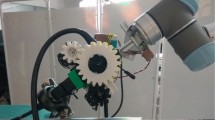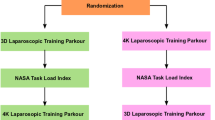Abstract
Background
Location of the image display is one of several factors that influence perceptual processing and endoscopic manipulation in minimal access surgery. Previous studies have proved the benefits of the gaze-down stance, as compared with the conventional gaze-up stance. This study investigates the effect of the gaze-down stance on the performance of a task with varying manipulative and perceptual demands.
Methods
The participants in this study were 20 medical students. Each student performed endoscopic touching tasks under standard conditions using the Dundee Projection System (DPS) display, positioned to provide gaze-up and gaze-down stances. To increase task complexity, two kinds of manual coordination (unilateral vs bilateral) and three endoscope positions (different positions of misalignment) were used. The outcome measures were task execution time and number of errors.
Results
Overall, the gaze-down stance reduced time and errors, as compared with the gaze-up display. However, the benefit obtained from the gaze-down stance was more significant in the more difficult tasks (bilateral task and 90° misalignments).
Conclusions
The gaze-down stance reduces task time and errors, as compared with a gaze-up stance. The reduction in time and errors is more appreciable as task complexity increases.



Similar content being viewed by others
References
S Abeele O Bock (2001) ArticleTitleSensorimotor adaptation to rotated visual input: different mechanisms for small versus large rotations Exp Brain Res 140 407–410 Occurrence Handle10.1007/s002210100846 Occurrence Handle1:STN:280:DC%2BD3MnhtVagtQ%3D%3D Occurrence Handle11685393
P Breedveld M Wentink (2001) ArticleTitleEye–hand coordination in laparoscopy: an overview of experiments and supporting aids Min Invas Ther Allied Technol 10 155–162 Occurrence Handle10.1080/136457001753192277
AB Cresswell AI Macmillan GB Hanna A Cuschieri (1999) ArticleTitleMethods for improving performance under reverse alignment conditions during endoscopic surgery Surg Endosc 13 591–594 Occurrence Handle10.1007/s004649901048 Occurrence Handle1:STN:280:DyaK1M3nvVGntg%3D%3D Occurrence Handle10347298
GB Hanna SM Shimi A Cuschieri (1998) ArticleTitleTask performance in endoscopic surgery is influenced by location of the image display Ann Surg 227 481–484 Occurrence Handle10.1097/00000658-199804000-00005 Occurrence Handle1:STN:280:DyaK1c3it12qtQ%3D%3D Occurrence Handle9563533
WH Ittelson (1993) ArticleTitleMirror reversals: real and perceived Perception 22 855–861 Occurrence Handle1:STN:280:ByuC2MbksVA%3D Occurrence Handle8115243
NJ Wade (1996) ArticleTitleFrames of reference in vision Min Invas Ther Allied Technol 5 435–439
RB Welch (1986) Adaptation of space perception KR Boff L Kaufman JP Thomas (Eds) Handbook of perception and human performance Wiley New York 24.1–24.45
RB Welch (1978) Perceptual modification: adaptation to altered sensory environments Academic Press New York
M Wentink P Breedveld DW Meijer HG Stassen (2000) ArticleTitleEndoscopic camera rotation: a conceptual solution to improve hand–eye coordination in minimally invasive surgery Min Invas Ther Allied Technol 9 125–132
M Wentink JJ Jakimowicz LM Vos DW Meijer PA Wieringa (2002) ArticleTitleQuantitative evaluation of three advanced laparoscopic viewing technologies: a stereo endoscope, an image projection display, and a TFT display Surg.Endosc 16 1237–1241 Occurrence Handle10.1007/s00464-001-9127-1 Occurrence Handle1:STN:280:DC%2BD38vjt1egtA%3D%3D Occurrence Handle11984691
B Zheng Z Janmohamed CL MacKenzie (2003) ArticleTitleReaction times and the decision-making process in endoscopic surgery Surg Endosc 17 1475–1480 Occurrence Handle10.1007/s00464-002-8759-0 Occurrence Handle1:STN:280:DC%2BD2c7ks1OmtQ%3D%3D Occurrence Handle12811661
Author information
Authors and Affiliations
Corresponding author
Rights and permissions
About this article
Cite this article
Omar, A.M., Wade, N.J., Brown, S.I. et al. Assessing the benefits of “gaze-down” display location in complex tasks. Surg Endosc 19, 105–108 (2005). https://doi.org/10.1007/s00464-004-8141-5
Received:
Accepted:
Published:
Issue Date:
DOI: https://doi.org/10.1007/s00464-004-8141-5




